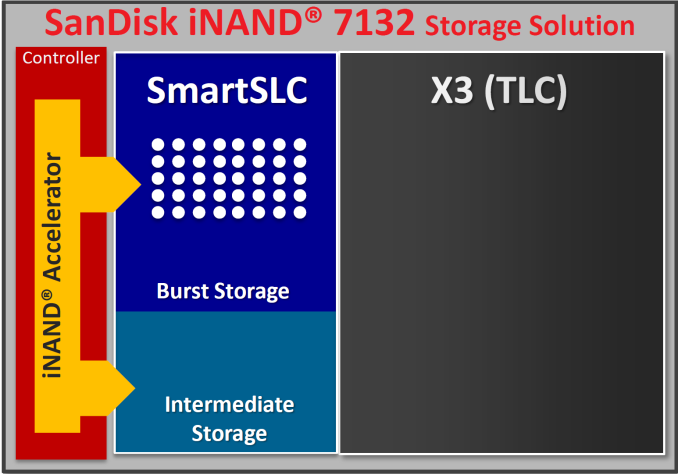SanDisk Announces iNAND 7132: SLC/TLC Hybrid eMMC
by Joshua Ho on March 2, 2015 1:00 AM EST- Posted in
- Smartphones
- SanDisk
- Mobile
- Tablets
- Trade Shows
- MWC 2015

In general, storage performance has been an area that is only discussed when it becomes a bottleneck. There was very little focus on storage performance in general before devices like the original Nexus 7 started experiencing severe performance issues due to IO pauses. However, delivering high performance storage performance has generally limited storage SKUs to 32GB or less, as the cost of such storage is generally difficult to justify otherwise.
This is a problem that SanDisk hopes to solve with their new iNAND 7132, which uses a hybrid SLC/TLC architecture to deliver both high burst performance and cheaper storage for a given design. SanDisk claims that typical storage usage is extremely peaky in nature, even with seemingly contiguous data streams. In addition, relatively few cases can truly saturate modern eMMC on a smartphone even when using a TLC-based solution.
By integrating an SLC cache into the eMMC package, it’s possible to achieve peak sequential reads of up to 280 MB/s, sequential writes of up to 125 MB/s, and up to 2800 and 3300 IOPS for random writes and reads, respectively. Based upon our discussions with SanDisk, it seems that the SLC cache is generally less than a gigabyte, but is usually enough to avoid situations where the SLC cache is filled and writes must go to the TLC storage.
SanDisk has also implemented a great deal of error correction and extensively tested this storage solution, and claims that eMMC solution can last 10 years of 24/7 intense use without data loss. The iNAND 7132 eMMC 5.0 solution is currently available in 16, 32, and 64 GB variants, with a 128GB variant arriving mid-year.











11 Comments
View All Comments
kyuu - Monday, March 2, 2015 - link
Curious how this compares to Samsung's UFS storage offerings in terms of performance and pricing. Seeing as Samsung claims "SSD-like" sequential performance and 19K IOPS random read, this solution would seem to be much poorer in the performance department.Hybridizing flash storage with an SLC cache is an interesting idea though.
hojnikb - Monday, March 2, 2015 - link
slc cache is nothing new with flash storage. SSDs are doing this for ages now.MrSpadge - Monday, March 2, 2015 - link
Few devices have implemented SLC or pseudo-SLC cache for a few years by now. It's not new, but neither is it generally available / established.hojnikb - Monday, March 2, 2015 - link
OCZ, Sandisk, Samsung and Micron are all doing pSLC now.And ocz is doing it since the vertex4 days.
SleepyFE - Monday, March 2, 2015 - link
I case you didn't notice SSDs don't fit into a phone. To get more than 16GB into a phone TLC is used. SLC means less capacity so this makes the news. It might work better. They should also try making more channels as SSDs use, though that would mean smaller NAND packages or more pins to access all those layers within the package.hojnikb - Monday, March 2, 2015 - link
>I case you didn't notice SSDs don't fit into a phone. To get more than 16GB into a phone TLC is used.You dont need TLC for more than 16GB. You can whach 256GB of MLC flash in a phone, if you wanted to. There are already 16 die 128Gbit MLC chips out there (1tb 840evo for example) so no reason phones cant have them.
blanarahul - Monday, March 2, 2015 - link
Yup. Including more channels/pins seems much more logical to me than introducing SLC.hojnikb - Monday, March 2, 2015 - link
Actually, pSLC makes much more sense than more channels or dies.More dies and channels means extra complexity on both packaging (as you need more dies for a given capacity) and beefier controller. That adds cost, which no one likes.
So emulating a SLC cache adds very little extra cost (since this is mostly a software thing) and can benefity greatly in burst performance.
jjj - Monday, March 2, 2015 - link
2 very different solutions, that Samsung is targeting the highest perf while this Sandisk product seems to be targeting decent perf in budget devices with minimal extra costs.One goes in the Galaxy S6 while the other one might go in the next Moto G and the likes.Do note that those Samsung perf claims were for the 128GB version and the smaller ones should be slower.
jjj - Monday, March 2, 2015 - link
I assume it's pseudo-SLC so they just expanded to mobile what they've been doing in PC SSD with nCache.